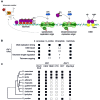Rif1: A Conserved Regulator of DNA Replication and Repair Hijacked by Telomeres in Yeasts
- PMID: 27066066
- PMCID: PMC4811881
- DOI: 10.3389/fgene.2016.00045
Rif1: A Conserved Regulator of DNA Replication and Repair Hijacked by Telomeres in Yeasts
Abstract
Rap1-interacting factor 1 (Rif1) was originally identified in the budding yeast Saccharomyces cerevisiae as a telomere-binding protein that negatively regulates telomerase-mediated telomere elongation. Although this function is conserved in the distantly related fission yeast Schizosaccharomyces pombe, recent studies, both in yeasts and in metazoans, reveal that Rif1 also functions more globally, both in the temporal control of DNA replication and in DNA repair. Rif1 proteins are large and characterized by N-terminal HEAT repeats, predicted to form an elongated alpha-helical structure. In addition, all Rif1 homologs contain two short motifs, abbreviated RVxF/SILK, that are implicated in recruitment of the PP1 (yeast Glc7) phosphatase. In yeasts the RVxF/SILK domains have been shown to play a role in control of DNA replication initiation, at least in part through targeted de-phosphorylation of proteins in the pre-Replication Complex. In human cells Rif1 is recruited to DNA double-strand breaks through an interaction with 53BP1 where it counteracts DNA resection, thus promoting repair by non-homologous end-joining. This function requires the N-terminal HEAT repeat-containing domain. Interestingly, this domain is also implicated in DNA end protection at un-capped telomeres in yeast. We conclude by discussing the deployment of Rif1 at telomeres in yeasts from both an evolutionary perspective and in light of its recently discovered global functions.
Keywords: DNA recombination; DNA repair; DNA replication timing; Rap1; Rif1; telomere; telomere capping.
Figures


Similar articles
-
Rif1 controls DNA replication timing in yeast through the PP1 phosphatase Glc7.Cell Rep. 2014 Apr 10;7(1):62-9. doi: 10.1016/j.celrep.2014.03.010. Epub 2014 Mar 27. Cell Rep. 2014. PMID: 24685139
-
Shepherding DNA ends: Rif1 protects telomeres and chromosome breaks.Microb Cell. 2018 May 17;5(7):327-343. doi: 10.15698/mic2018.07.639. Microb Cell. 2018. PMID: 29992129 Free PMC article. Review.
-
Rif1 controls DNA replication by directing Protein Phosphatase 1 to reverse Cdc7-mediated phosphorylation of the MCM complex.Genes Dev. 2014 Feb 15;28(4):372-83. doi: 10.1101/gad.231258.113. Genes Dev. 2014. PMID: 24532715 Free PMC article.
-
Protein phosphatase 1 recruitment by Rif1 regulates DNA replication origin firing by counteracting DDK activity.Cell Rep. 2014 Apr 10;7(1):53-61. doi: 10.1016/j.celrep.2014.02.019. Epub 2014 Mar 20. Cell Rep. 2014. PMID: 24656819 Free PMC article.
-
G-quadruplex binding protein Rif1, a key regulator of replication timing.J Biochem. 2021 Feb 6;169(1):1-14. doi: 10.1093/jb/mvaa128. J Biochem. 2021. PMID: 33169133 Review.
Cited by
-
Insights into the Possible Molecular Mechanisms of Resistance to PARP Inhibitors.Cancers (Basel). 2022 Jun 5;14(11):2804. doi: 10.3390/cancers14112804. Cancers (Basel). 2022. PMID: 35681784 Free PMC article. Review.
-
Temporal control of late replication and coordination of origin firing by self-stabilizing Rif1-PP1 hubs in Drosophila.Proc Natl Acad Sci U S A. 2022 Jun 28;119(26):e2200780119. doi: 10.1073/pnas.2200780119. Epub 2022 Jun 22. Proc Natl Acad Sci U S A. 2022. PMID: 35733247 Free PMC article.
-
The Tousled-like kinases regulate genome and epigenome stability: implications in development and disease.Cell Mol Life Sci. 2019 Oct;76(19):3827-3841. doi: 10.1007/s00018-019-03208-z. Epub 2019 Jul 13. Cell Mol Life Sci. 2019. PMID: 31302748 Free PMC article. Review.
-
Rif1 maintains telomeres and mediates DNA repair by encasing DNA ends.Nat Struct Mol Biol. 2017 Jul;24(7):588-595. doi: 10.1038/nsmb.3420. Epub 2017 Jun 12. Nat Struct Mol Biol. 2017. PMID: 28604726
-
Alternative splicing modulates chromatin interactome and phase separation of the RIF1 C-terminal domain.bioRxiv [Preprint]. 2024 Nov 1:2024.10.29.619708. doi: 10.1101/2024.10.29.619708. bioRxiv. 2024. PMID: 39553946 Free PMC article. Preprint.
References
LinkOut - more resources
Full Text Sources
Other Literature Sources
Molecular Biology Databases
Miscellaneous

